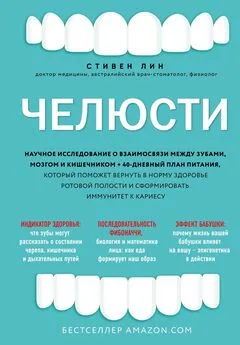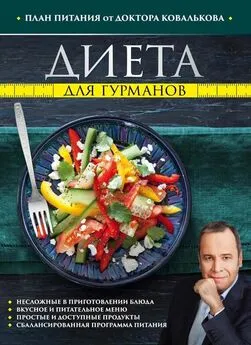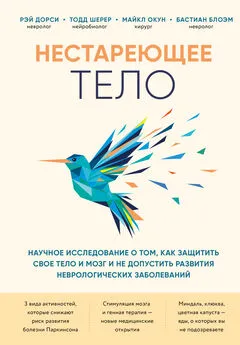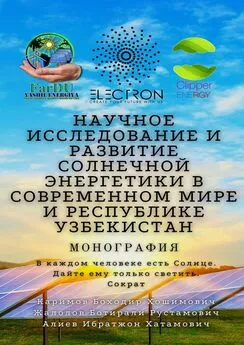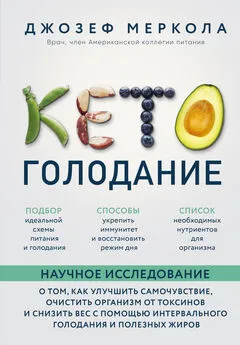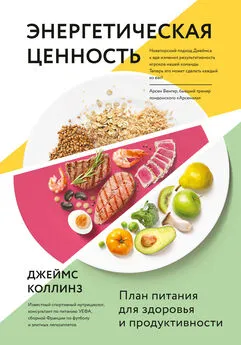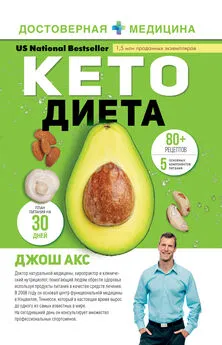Стивен Лин - Челюсти. Научное исследование о взаимосвязи между зубами, мозгом и кишечником + 40-дневный план питания, который поможет вернуть в норму здоровье ротовой полости и сформировать иммунитет к кариесу
- Название:Челюсти. Научное исследование о взаимосвязи между зубами, мозгом и кишечником + 40-дневный план питания, который поможет вернуть в норму здоровье ротовой полости и сформировать иммунитет к кариесу
- Автор:
- Жанр:
- Издательство:неизвестно
- Год:2018
- ISBN:978-5-04-108563-6
- Рейтинг:
- Избранное:Добавить в избранное
-
Отзывы:
-
Ваша оценка:
Стивен Лин - Челюсти. Научное исследование о взаимосвязи между зубами, мозгом и кишечником + 40-дневный план питания, который поможет вернуть в норму здоровье ротовой полости и сформировать иммунитет к кариесу краткое содержание
Челюсти. Научное исследование о взаимосвязи между зубами, мозгом и кишечником + 40-дневный план питания, который поможет вернуть в норму здоровье ротовой полости и сформировать иммунитет к кариесу - читать онлайн бесплатно ознакомительный отрывок
Интервал:
Закладка:
33. Guilleminault, Christian, John L. Faul, and Riccardo Stoohs. “Sleepdisordered breathing and hypotension.” American journal of respiratory and critical care medicine 164, no. 7 (2001): 1242–1247.
34. Kunter, Erdogan, Ozkan Yetkin, and Hakan Gunen. “UARS presenting with the symptoms of anxiety and depression.” Central European journal of medicine 5.6 (2010): 712–715.
35. de Godoy, Luciana Balester Mello, Gabriela Pontes Luz, Luciana Oliveira Palombini, Luciana Oliveira e Silva, Wilson Hoshino, Thais Moura Guimaraes, Sergio Tufik, Lia Bittencourt, and Sonia Maria Togeiro. “Upper Airway Resistance Syndrome Patients Have Worse Sleep Quality Compared to Mild Obstructive Sleep Apnea.” PLoS ONE 11, no. 5 (2016): e0156244–e0156244.
36. El Shakankiry, Hanan M. “Sleep physiology and sleep disorders in childhood.” Nature and science of sleep 3 (2011): 101.
37. Gozal, David. “Obstructive sleep apnea in children: implications for the developing central nervous system.” Seminars in pediatric neurology 15, no. 2. W. B. Saunders, 2008.
38. Scott, Nicola, et al. “Sleep patterns in children with ADHD: a population‐based cohort study from birth to 11 years.” Journal of sleep research 22.2 (2013): 121–128.
39. Iftikhar, Imran H., Christopher E. Kline, and Shawn D. Youngstedt. “Effects of exercise training on sleep apnea: a meta-analysis.” Lung 192.1 (2014): 175–184.
40. Puhan, Milo A., et al. “Didgeridoo playing as alternative treatment for obstructive sleep apnoea syndrome: randomised controlled trial.” BMJ 332.7536 (2006): 266–270.
Глава 4
1. Farges, Jean-Christophe, Aurélie Bellanger, Maxime Ducret, Elisabeth Aubert Foucher, Béatrice Richard, Brigitte Alliot-Licht, Françoise Bleicher, and Florence Carrouel. “Human odontoblast-like cells produce nitric oxide with antibacterial activity upon TLR2 activation.” Frontiers in physiology 6, June (2015): 185.
2. Hu, B., et al. “Bone marrow cells can give rise to ameloblast-like cells.” Journal of dental research 85.5 (2006): 416–421.
3. Takayanagi, Hiroshi. “Osteoimmunology: shared mechanisms and crosstalk between the immune and bone systems.” Nature reviews immunology 7.4 (2007): 292–304.
4. Arana-Chavez, Victor E., and Luciana F. Massa. “Odontoblasts: the cells forming and maintaining dentine.” International journal of biochemistry & cell biology 36, no. 8 (2004): 1367–1373.
5. Nagaoka, Shigetaka, Youichi Miyazaki, Hong-Jih Liu, Yuko Iwamoto, Motoo Kitano, and Masataka Kawagoe. “Bacterial invasion into dentinal tubules of human vital and nonvital teeth.” Journal of endodontics 21, no. 2 (1995): 70–73.
6. Berdal, A., P. Papagerakis, D. Hotton, I. Bailleul-Forestier, and J. L. Davideau. “Ameloblasts and odontoblasts, target-cells for 1, 25-dihydroxyvitamin D3: a review.” International journal of developmental biology 39, no. 1 (2003): 257–262.
7. Lemire, Jacques M., J. S. Adams, R. Sakai, and S. C. Jordan. “1 alpha, 25-dihydroxyvitamin D3 suppresses proliferation and immunoglobulin production by normal human peripheral blood mononuclear cells.” Journal of clinical investigation 74, no. 2 (1984): 657.
8. Tang, Jun, Ru Zhou, Dror Luger, Wei Zhu, Phyllis B. Silver, Rafael S. Grajewski, Shao-Bo Su, Chi-Chao Chan, Luciano Adorini, and Rachel R. Caspi. “Calcitriol suppresses antiretinal autoimmunity through inhibitory effects on the Th17 effector response.” Journal of immunology 182, no. 8 (2009): 4624–4632.
9. Papagerakis, P., M. MacDougall, D. Hotton, I. Bailleul-Forestier, M. Oboeuf, and A Berdal. “Expression of amelogenin in odontoblasts.” Bone 32, no. 3 (2003): 228–240.
10. Schroth, R. J., R. Rabbani, G. Loewen, and M. E. Moffatt. “Vitamin D and dental caries in children.” Journal of dental research 95, no.2 (2016): 173–179.
11. Hildebolt, Charles F. “Effect of vitamin D and calcium on periodontitis.” Journal of periodontology 76, no. 9 (2005): 1576–1587.
12. Heaney, Robert P. “Vitamin D and calcium interactions: functional outcomes.” American journal of clinical nutrition 88, no. 2 (2008): 541S–544S.
13. Guimarães, Gustavo Narvaes, Thaisângela Lopes Rodrigues, Ana Paula de Souza, Sergio Roberto Line, and Marcelo Rocha Marques. “Parathyroid hormone (1–34) modulates odontoblast proliferation and apoptosis via PKA and PKC-dependent pathways.” Calcified tissue international 95, no. 3 (2014): 275–281.
14. Ramagopalan, Sreeram V., Andreas Heger, Antonio J. Berlanga, Narelle J. Maugeri, Matthew R. Lincoln, Amy Burrell, Lahiru Handunnetthi, et al. “A ChIP-seq defined genome-wide map of vitamin D receptor binding: associations with disease and evolution.” Genome research 20, no. 10 (2010): 1352–1360.
15. Nair, Rathish, and Arun Maseeh. “Vitamin D: the ‘sunshine’ vitamin.” Journal of pharmacology and pharmacotherapeutics 3, no. 2 (2012): 118.
16. Garland, Cedric F., Frank C. Garland, Edward D. Gorham, Martin Lipkin, Harold Newmark, Sharif B. Mohr, and Michael F. Holick. “The role of vitamin D in cancer prevention.” American journal of public health 96, no. 2 (2006): 252–261.
17. Littlejohns, Thomas J., William E. Henley, Iain A. Lang, Cedric Annweiler, Olivier Beauchet, Paulo H. M. Chaves, Linda Fried, et al. “Vitamin D and the risk of dementia and Alzheimer disease.” Neurology 83, no. 10 (2014): 920–928.
18. Pierrot-Deseilligny, Charles, and Jean-Claude Souberbielle. “Contribution of vitamin D insufficiency to the pathogenesis of multiple sclerosis.” Therapeutic advances in neurological disorders 6, no. 2 (2013): 81–116.
19. Xu, Qun, Christine G. Parks, Lisa A. DeRoo, Richard M. Cawthon, Dale P. Sandler, and Honglei Chen. “Multivitamin use and telomere length in women.” American journal of clinical 89 (2009): 1857–1863.
20. Vimaleswaran, Karani S., Diane J. Berry, Chen Lu, Emmi Tikkanen, Stefan Pilz, Linda T. Hiraki, Jason D. Cooper, et al. “Causal relationship between obesity and vitamin D status: bi-directional Mendelian randomization analysis of multiple cohorts.” PLoS Med 10, no. 2 (2013): 1–13.
21. Khayyat, Yasir, and Suzan Attar. “Vitamin D deficiency in patients with irritable bowel syndrome: does it exist?” Oman medical journal 30, no. 2 (2015): 115.
22. Tavakkoli, Anna, Daniel DiGiacomo, Peter H. Green, and Benjamin Lebwohl. “Vitamin D status and concomitant autoimmunity in celiac disease.” Journal of clinical gastroenterology 47, no. 6 (2013): 515.
23. Blanck, Stacey, and Faten Aberra. “Vitamin D deficiency is associated with ulcerative colitis disease activity.” Digestive diseases and sciences 58, no. 6 (2013): 1698–1702.
24. Ham, Maggie, Maria S. Longhi, Conor Lahiff, Adam Cheifetz, Simon Robson, and Alan C. Moss. “Vitamin D levels in adults with Crohn’s disease are responsive to disease activity and treatment.” Inflammatory bowel diseases 20, no. 5 (2014): 856.
25. Loeser, Richard F. “Age-related changes in the musculoskeletal system and the development of osteoarthritis.” Clinics in geriatric medicine 26, no. 3 (2010): 371–386.
26. Bolland, Mark J., Andrew Grey, Alison Avenell, Greg D. Gamble, and Ian R. Reid. “Calcium supplements with or without vitamin D and risk of cardiovascular events: reanalysis of the Women’s Health Initiative limited access dataset and meta-analysis.” BMJ 342 (2011): d2040.
27. Semba, R., and K. Kramer. “The discovery of the vitamins.” Ann Nutr Metab 61, no. 3 (2012): 181–270.
28. Dam, Henrik. “The antihaemorrhagic vitamin of the chick. Occurrence and chemical nature.” Nature 135, no. 18 (1935): 652–653.
29. Howard, James Bryant, and Gary L. Nelsestuen. “Isolation and characterization of vitamin K-dependent region of bovine blood clotting factor X.” Proceedings of the National Academy of Sciences 72, no. 4 (1975): 1281–1285.
30. Iłowiecki, Maciej. Dzieje nauki polskiej. Warszawa: Wydawnictwo Interpress, 1981, p. 177.
31. Hauschka, P. V. “Osteocalcin: the vitamin K-dependent Ca2+-binding protein of bone matrix.” Pathophysiology of haemostasis and thrombosis 16, no. 3–4 (1986): 258–272.
32. Schurgers, Leon J., Ellen C. M. Cranenburg, and Cees Vermeer. “Matrix GLAprotein: the calcification inhibitor in need of vitamin K.” Thrombosis and haemostasis 100, no. 4 (2008): 593–603.
33. Luo, Guangbin, Patricia Ducy, Marc D. McKee, Gerald J. Pinero, Evelyne Loyer, Richard R. Behringer, and Gérard Karsenty. “Spontaneous calcification of arteries and cartilage in mice lacking matrix GLA protein.”Nature 386, no.6620 (1997): 78–81.
34. Geleijnse, Johanna M., Cees Vermeer, Diederick E. Grobbee, Leon J. Schurgers, Marjo H. J. Knapen, Irene M. Van Der Meer, Albert Hofman, and Jacqueline C. M. Witteman. “Dietary intake of menaquinone is associated with a reduced risk of coronary heart disease: the Rotterdam study.” Journal of nutrition 134, no. 11 (2004): 3100–3105.
35. Vermeer, Cees, Martin J. Shearer, Armin Zittermann, Caroline BoltonSmith, Pawel Szulc, Stephen Hodges, Paul Walter, Walter Rambeck, Elisabeth Stöcklin, and Peter Weber. “Beyond deficiency.” European journal of nutrition 43, no. 6 (2004): 325–335.
36. Falcone, Trasey D., Scott S. W. Kim, and Megan H. Cortazzo. “Vitamin K: fracture prevention and beyond.” PM&R 3, no. 6 (2011): S82–S87.
37. Masterjohn, Chris. “On the trail of the elusive X-factor: a sixty-two-year-old mystery finally solved – Weston A. Price.” Weston A. Price. Washington, D.C. Weston A. Price Foundation, 14 Feb. 2008. Web. 11 Dec. 2014.
38. Hauschka, P. V. “Osteocalcin: the vitamin K-dependent Ca2+-binding protein of bone matrix.” Pathophysiology of haemostasis and thrombosis 16, no. 3–4 (1986): 258–272.
39. Schurgers, Leon J., Daniela V. Barreto, Fellype C. Barreto, Sophie Liabeuf, Cédric Renard, Elke J. Magdeleyns, Cees Vermeer, Gabriel Choukroun, and Ziad A. Massy. “The circulating inactive form of matrix GLA protein is a surrogate marker for vascular calcification in chronic kidney disease: a preliminary report.” Clinical journal of the American Society of Nephrology 5, no. 4 (2010): 568–575.
40. Thomsen, Stine B., Camilla N. Rathcke, Bo Zerahn, and Henrik Vestergaard. “Increased levels of the calcification marker matrix GLA protein and the inflammatory markers YKL-40 and CRP in patients with type 2 diabetes and ischemic heart disease.” Cardiovascular diabetology 9, no. 1 (2010): 1.
41. Westenfeld, Ralf, Thilo Krueger, Georg Schlieper, Ellen C. M. Cranenburg, Elke J. Magdeleyns, Stephan Heidenreich, Stefan Holzmann, et al. “Effect of vitamin K2 supplementation on functional vitamin K deficiency in hemodialysis patients: a randomized trial.” American journal of kidney diseases 59, no. 2 (2012): 186–195.
42. Schurgers, Leon J., Daniela V. Barreto, Fellype C. Barreto, Sophie Liabeuf, Cédric Renard, Elke J. Magdeleyns, Cees Vermeer, Gabriel Choukroun, and Ziad A. Massy. “The circulating inactive form of matrix GLA protein is a surrogate marker for vascular calcification in chronic kidney disease: a preliminary report.” Clinical journal of the American Society of Nephrology 5, no. 4 (2010): 568–575.
43. Shimamoto S., A. Tanaka, K. Tsuchida, K. Hayashi, and T. Sawa. “Serious coagulation dysfunction in a patient with gallstone-related cholecystitis successfully treated with vitamin K.” Japanese journal of anesthesiology 65(4) (2016):407–410 (Japanese).
44. Nimptsch, Katharina, Sabine Rohrmann, and Jakob Linseisen. “Dietary intake of vitamin K and risk of prostate cancer in the Heidelberg cohort of the European Prospective Investigation into Cancer and Nutrition (EPICHeidelberg).” American journal of clinical nutrition 87, no. 4 (2008): 985–992.
Читать дальшеИнтервал:
Закладка:
